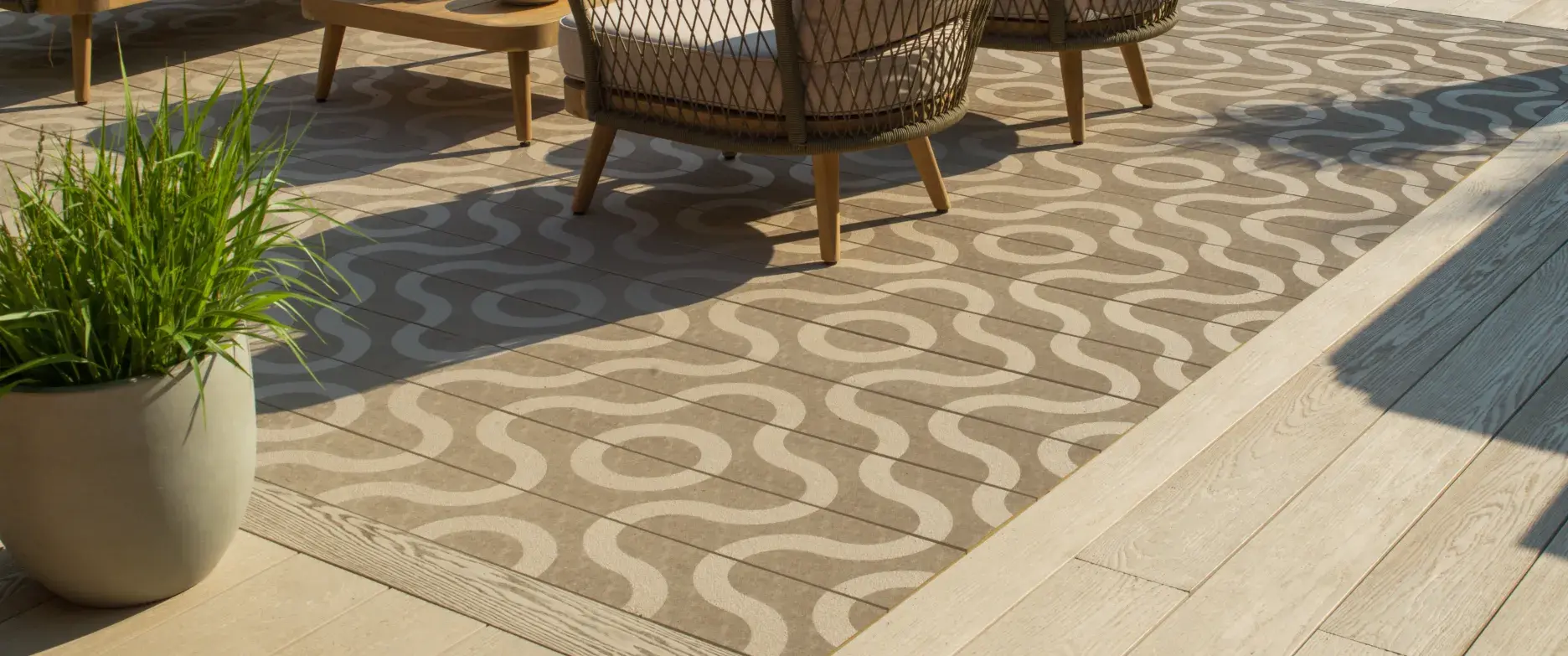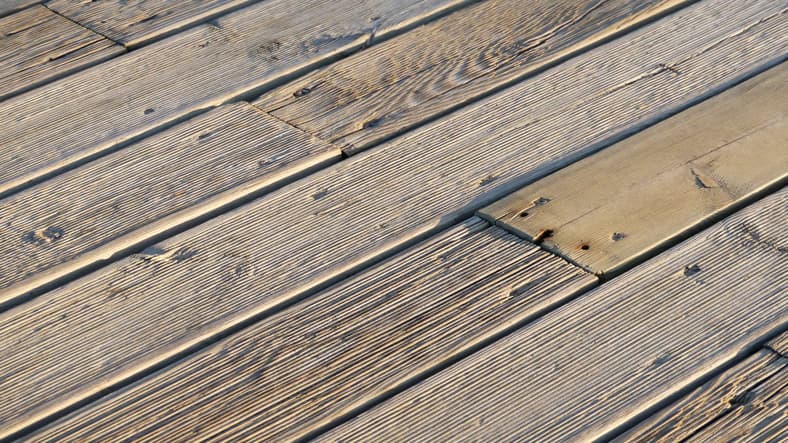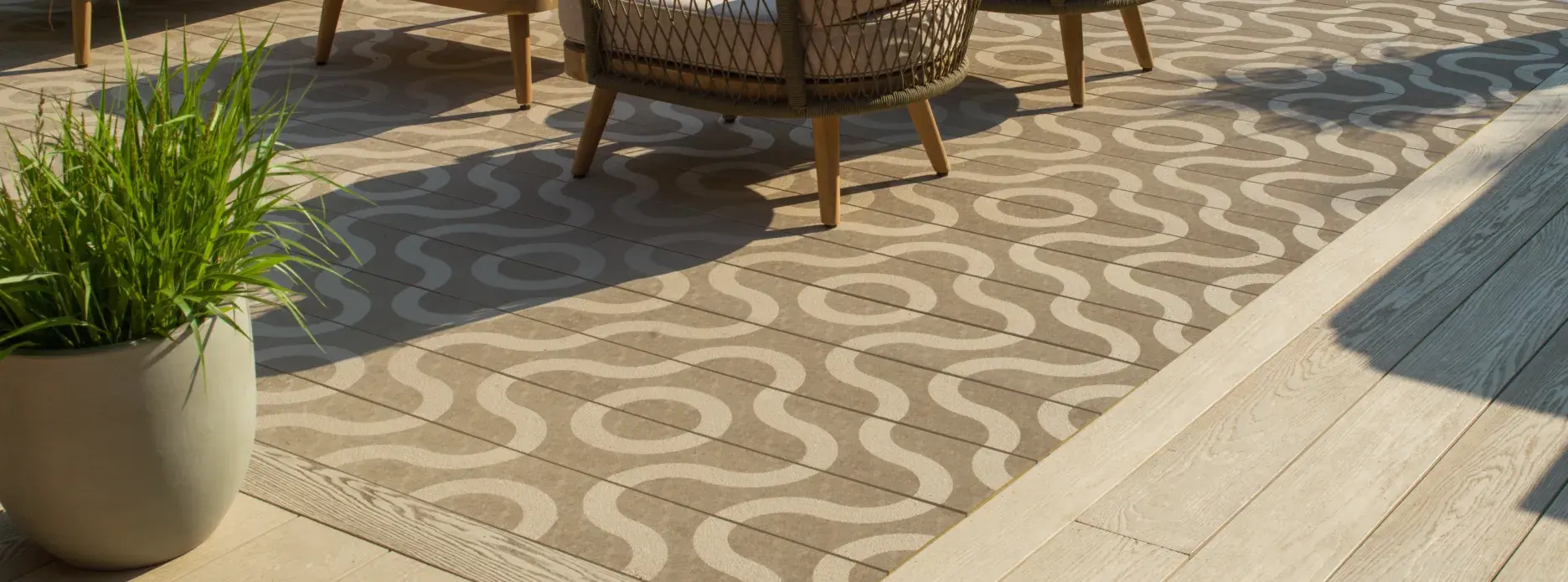MIllboard knowledgebase
Why Should You Choose Warp-Resistant Composite Decking? | Benefits & Features

Article Highlights
Outdoor decking is a beloved feature in gardens, patios, and commercial spaces. However, choosing the right decking material can be a daunting task, especially with the challenges posed by environmental factors such as moisture and temperature fluctuations.
One of the most significant issues faced by decking materials is warping, which can compromise both the appearance and safety of your outdoor space.
In this guide, we will explore the benefits of incorporating warp-resistant decking in your outdoor living space, the key features of Millboard composite decking, and what to look out for to prevent damage.
What is Warping, and How Does it Affect Outdoor Decking?
Warping is a common issue with wooden decking, where constant exposure to the elements can cause structural damage, uneven surfaces, and safety risks. It occurs when a material bends, twists, or curves out of its original shape, often due to uneven moisture absorption or exposure to extreme temperature changes.
Wooden decking is especially prone to warping due to its natural composition. When wood absorbs moisture from rain or humidity, it expands, and as it dries, it contracts. This repeated cycle can lead to boards cupping, bowing, or twisting.
The impact of warping on outdoor decking goes beyond aesthetics. A warped deck can compromise safety by creating tripping hazards or unstable surfaces. Moreover, warping can disrupt the alignment of the decking boards, making the installation look uneven and reducing its overall lifespan.

Composite decking is designed to solve these problems. Generally made from a combination of wood fibres and polymers, these deck boards offer the classic look of wood with superior durability. Millboard composite does not contain timber, and it experiences less expansion and contraction compared with wooden alternatives, making it an excellent choice for outdoor decking.
Common Causes of Deck Warping in the UK
The UK's weather, with its wet winters and changing temperatures, creates certain problems for natural wood decking. Frequent rain can lead to damp boards, increasing moisture absorption and opportunities for potential warping.
Direct sunlight can contribute to warping too. When one side of timber material gets hotter than the other, it expands unevenly, causing the boards to twist or cup.
Additionally, the freeze-thaw cycles during the UK's winter months can worsen warping. Water trapped in the boards can freeze and expand, putting pressure on the decking materials. When this happens repeatedly, it can harm the wood fibres, making the decking more likely to warp or sustain other damage.
Incorrectly installed decking may also lead to warping due to potential spacing inaccuracies between the boards. Using professional installers, who are trained on products, specialist tools, and installation practices, helps ensure that the composite decking installation is correct.
Our Millboard-approved installers are well-versed in the specific requirements and will deliver high-quality installations to ensure adequate spacing.
Comparing Warp-Resistant Composite Decking vs Other Materials
Composite decking stands out for its warp-resistant properties, which are crucial for outdoor spaces that face moisture and temperature changes. Unlike wood, it doesn't warp or rot, and has a low water absorption rate. The durability of composite products surpasses that of traditional wooden options, requiring minimal maintenance and resisting warping.
Deciding on the right decking material is key for longevity and the quality of an outdoor space. Though aesthetics are also an important factor. Homeowners should consider a decking material that offers strong resistance to warping and other environmental stressors.
Wooden Decking
Natural wooden decking, while traditional, is prone to changing shape due to moisture absorption and temperature fluctuations. This natural material requires regular maintenance to prevent issues like rot and staining. In the UK, wooden decks are especially susceptible to warping during the wet winter months.
Despite its natural and rustic charm, wooden decking demands diligent care and upkeep compared to warp-resistant composite options.
PVCDecking
While cost-effective, PVC decking can be prone to warping in extremely high or low temperatures. The material's susceptibility to heat and cold may cause it to bow.
Proper care and maintenance are essential to ensure a longer lifespan and optimal safety of your outdoor space. Look for premium materials with a low expansion and contraction rate.
Millboard Composite Decking
Millboard's composite decking is highly resistant to warping due to its wood-free composition. This unique blend ensures low moisture absorption, making it highly durable against temperature fluctuations and direct sunlight exposure.
With a low water absorption rate, Millboard composite decking maintains its structural integrity, avoiding the common issue of warping that traditional wooden decking often faces. Its premium materials and quality construction make it a preferred choice for long-lasting outdoor spaces.
Compare the different decking materials below:
|
Material |
Susceptibility to warping |
Moisture absorption |
Expansion & contraction |
Aesthetic appeal |
|
Wooden decking |
High |
Absorbs moisture easily |
Significant under-temperature changes |
Natural and warm, but high maintenance |
|
PVCdecking |
Low |
Does not absorb moisture |
Prone to buckling in extreme heat |
Less natural appearance |
|
Composite decking |
Very low |
Minimal to no absorption |
Negligible, even in extreme climates |
Highly realistic and attractive |
For more information, compare composite decking against wooden decking, PVC decking, and other materials with our expert guide here.
Key Features of Millboard's Warp-Resistant Composite Decking
Millboard’s composite decking offers a range of innovative features that make it exceptionally warp-resistant and highly durable:
- Composition: Millboard composite decking uses a polyurethane resin core combined with a tough Lastane™ surface layer.
- Moisture resistance: The absence of wood fibres eliminates the risk of water absorption, preventing the expansion and contraction cycles which cause warping in traditional decking materials.
- Durability and low maintenance: Millboard's composite boards are highly resistant to mould and rot, enhancing long-term performance and reducing maintenance requirements.
- Thermal stability: Designed to withstand both hot and cold conditions, Millboard’s polyurethane core resists significant thermal expansion and contraction, making it ideal for variable climates.
- Realistic aesthetic: Hand-moulded from vintage oak boards, Millboard composite decking replicates the classic and natural timber grain patterns, providing the warmth and character of wood without the associated drawbacks.
- Additional Features: Highly Slip-resistant, highly UV-stable, and available in various colours and finishes, Millboard’s decking caters to both functional and aesthetic preferences.
Millboard composite decking offers a safer surface for outdoor living spaces, featuring enhanced slip resistance and protection against warping. Our decking collections perfectly replicate the classic wooden look with amplified durability and several colour options to choose from.
Browse our composite decking collections:
Experience the market-leading composite for yourself – sample your favourites.
If you have any questions, please do not hesitate to contact the Millboard team.
Top Tips for Preventing Warping in Your Outdoor Space
Although composite decking offers strong resistance to warping, there are steps you can take to help it last longer and maintain its appearance. Taking proper care of a few key areas can make a significant difference.
Preventing the warping of composite decking starts with selecting high-quality materials, as well as proper installation and maintenance to ensure longevity. Choosing a warp-resistant product like Millboard is a proactive step, but there are additional measures you can take to maintain a pristine and functional outdoor space.
Ensure your decking is installed on a stable and well-prepared foundation. To provide a sturdy base, the subframe should be constructed from durable, moisture-resistant materials, such as treated timber or metal.
Proper spacing between the boards is also essential to allow for ventilation and drainage, which helps prevent moisture accumulation beneath the decking. It is recommended to seek a professional installer who understands the complexities of the product, its fixings, and the necessary tools to ensure a perfect fit. Find your nearest Millboard-approved installer here.
Regular cleaning and upkeep are also crucial. Although composite decking requires less maintenance than wood, removing debris and dirt can prevent moisture from sitting on the surface.
Frequently Asked Questions
How does warp-resistant composite decking combat the UK's weather?
Composite decking boards are designed to be strong and durable, lasting a long time even in varying weather conditions. They need little upkeep and don’t warp easily. This makes composite decking a great choice for the changing climate in the UK.
How does the maintenance of warp-resistant composite decking differ from traditional wood decking?
Low-maintenance composite deck boards need very little care. Unlike wood, a quick clean with composite decking cleaner is often enough. Though an initial higher upfront cost, choosing quality composite decking means you will have less work and more time to enjoy your deck in the long run.





